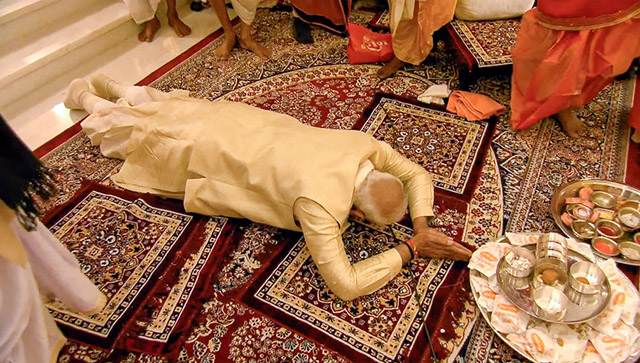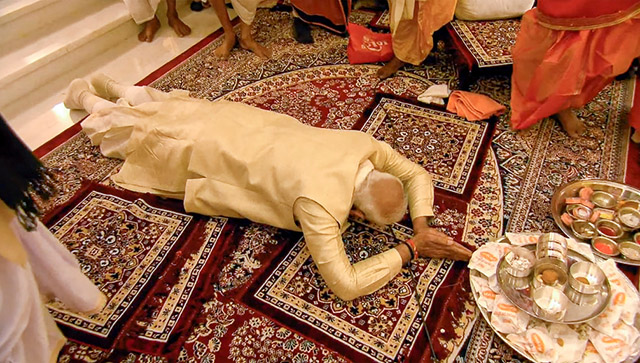It’s easy to see how a young woman called Meera fell madly in love with the idea of a blue skinned flautist in the 14th century. Krishna is a compelling god, one of the most human — the other was Ram, but he was known for his almost celibate monogamy. Krishna, on the other hand, began his life romping with women.
Think of the infamous scene from the Rasa-lila, a joyful dance that describes Krishna’s life, where he follows the gopis (the lady cowherds) to their bathing place, and while they’re distracted, he steals their clothes. They beg him to return their garments. In most paintings, he’s depicted sitting on the branches of a tree, telling them to come and get their clothes if they want them. Eventually, they agree, and I imagine, each walks out of the pond naked to dry themselves off. It’s an intense, sensual image — Krishna as the tormentor, Krishna as the lover — and more has been made of this aspect of the god than his lecture on duty and the righteous path that he delivers much later in the Mahabharata.
There’s another bit in the same Rasa-lila, where he calls to his gopis to join him in the forest on a moonlit night: there they frolic; Krishna splitting himself up into several Krishnas, so each would have her own personal attendant, as well as standing in the middle of the circle, playing the flute, as they joined hands and danced around him. It makes you wonder if they were all a little high, because this sounds very much like the time I took some shrooms on a beach in Thailand and saw dancing sea turtles everywhere.
(You could get high in ancient India if you took enough soma, but no one quite knows what went into it, though people have been trying to recreate it for generations.)
Anyway, the Krishna splitting himself into many Krishnas a la The Parent Trap (except in a more divine fashion than Lindsey Lohan, one imagines), was also carried over to his treatment of his wives. He had eight principal wives — known collectively as the ashtabharyas — but also 16,000 junior wives. That’s actually not as salacious as it sounds — he rescued them all from an evil demon, and when they begged him to marry them, he did, and then did the splitting himself up thing again, so each wife got to spend the night with her own Krishna husband, who also hung about, did some chores, played with his children and so on.
But this is not a story about Krishna’s amazing husband skills, although those are pretty impressive. This is the story of the one woman he loved who he didn’t marry, because she was already married at the time. This is the story of Radha.
Radha is a goddess in Hindu mythology, but her divinity only happened a little later. According to mythologist Devdutt Pattanaik, it was only around the 10th century that some Prakrit literature started to refer to one particular gopi set above the rest. There was also a reference to a Nal-Pinnai in a Tamil epic in the fifth century, says Pattanaik, a gopi who got dust in her eye which Krishna removed, but it wasn’t until the 12th century when a poet called Jayadeva composed a tremendous poem of love and longing called the Gita Govinda that Radha really began to take shape.
That Radha was already married adds a certain slant to looking at this love story, as opposed to all the others in Hindu mythology. We’ve seen great love stories before, but they always have a happy ending, the man overcomes all odds, the woman is rewarded for her steadfast devotion, they live happily ever after and have several sons. The crux of the Krishna-Radha story however is unhappiness — they meet in secret, they know what they’re doing is wrong on a human level (there are some arguments that their love is divine, pre-ordained, not physical at all), it’s all very Romeo and Juliet, except no one dies in the end. The idea being, I suppose, to establish Krishna as a person no one could resist, not even a married woman, but I am amazed by how liberal the mythology was around Radha, certainly far more liberal than today, which makes me sad.
It’s hard for some devout Hindus to reconcile themselves with this aspect of their god. A sensual man? Fine. But a cheater? In David Kinsley’s Hindu Goddesses: Visions of the Divine Female in the Hindu Religious Tradition, he mentions that some Bengal Vaishnava theologians argue that actually illicit love is purer than married love. It’s “given freely, makes no legal claims and as such is selfless”. Married love is governed by lust, they say, and Radha’s love is love for her beloved, so, yeah. Remember to use that as an argument if you’re caught red handed on Ashley Madison. “Hey, if it’s good enough for Krishna and Radha…” (You’d also have to argue that your cheatee, as it were, is divine, in order to make that argument, but I can’t do all your work for you.)
But eventually, the cool thing about the Radha story is that she’s seen as equal to Krishna, the other half of his soul, split in two a long time before, and finally coming back to each other. Their love was inevitable, even though he left her behind and went on to conquer the world. You’ll always remember your first.
Read more from the ‘Mythology for the Millennial’ series here .
Meenakshi Reddy Madhavan is the author of several books, including The One Who Swam with the Fishes: Girls of the Mahabharata. She tweets @reddymadhavan


)




)
)
)
)
)
)
)
)